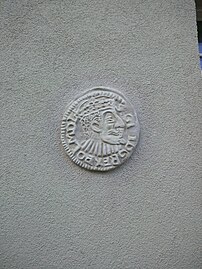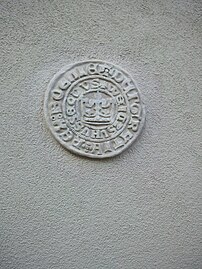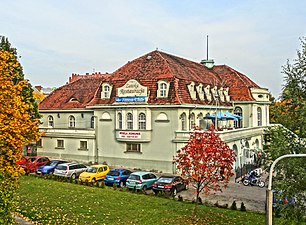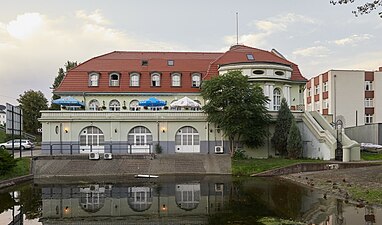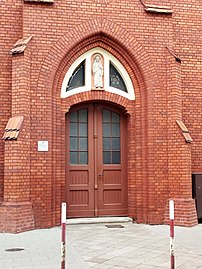Świętego Floriana Street
This article, Świętego Floriana Street, has recently been created via the Articles for creation process. Please check to see if the reviewer has accidentally left this template after accepting the draft and take appropriate action as necessary.
Reviewer tools: Inform author |
| Bydgoszcz | |
|---|---|
 View of the street eastwards | |
 Świętego Floriana Street highlighted on a map | |
| Native name | Polish: Ulica Świętego Floriana |
| Former name(s) | Alexander Straße, Frithjof Straße |
| Namesake | Saint Florian |
| Owner | City of Bydgoszcz |
| Length | 200 m (660 ft)Google maps |
| Width | ca. 10m |
| Area | Downtown district |
| Location | Bydgoszcz |
| Construction | |
| Construction start | 1908[1] |
| Completion | Early 1940s |
Świętego Floriana Street is located in downtown district, in Bydgoszcz, Poland. Despite its short length, many of its buildings display Eclectic, Art Nouveau or early modernist architectural styles.
Location
The axis is located nearby the Brda river, its track running parallel to the water, on a west-east axis. It stems out of Bernardyńska Street in the west and runs between the river and Jagiellońska street along 200m.
History
The area originally belonged to a city farm called Grodztwa[2]. Land registery cites that the farm owner successively sold pieces of the estate. Like many of the streets of downtown district, Świętego Floriana started between the last quarter of the 19th century[3] and the first quarter of the 20th century.
The street bore the following names through time[4]:
- 19th century - 1920, Alexander straße;
- 1920 - 1939, Ulica Świętego Floriana;
- 1939 - 1945, Frithjof straße, alluding to Frithiof's Saga;
- Since 1945, Ulica Świętego Floriana.
The street name sake refers to Saint Florian.
Main edifices
Tenement at No.3, corner with Bernardyńska Street
1910[5]
Before its erection in the beginning of the 20th century, the place was a garden. Carl Hintz, a mailman, was the first registered landlord[6].
The building has been thouroughly restored in 2018. One will notice the entry doorway, flanked by two columns, three medallions depicting figures (among whom a king) and a seal. Corner facades are topped with a ogee gables and eyelid dormers.
-
View from Bernardyńska street
-
Main door at No.3
-
View of the gables
-
Figure head medallion
-
King head medallion
-
Seal medallion
Tenement at No.5/7
Late 1930s
Those two buildings are part of a series of similar constructions that hatched in downtown Bydgoszcz during that period. Other instances can be found at Gdańska Street, Zamoyskiego Street or 20 Stycznia 1920 Street.
-
Facades view from the street
Old Building of Bydgoszcz Rowing Association, corner with Bernardyńska Street
Registered on Kuyavian-Pomeranian Heritage list N°601291, Reg.A/1091 (January 18, 1994)[7]
1914, by Theodore Patzwald
The building has been erected by the architect Theodore Patzwald for the German Rowing Club "Frithjof" established in 1894.[8] The club joined from 1923 to 1945 the "Frithjof Rowing Club", a German rowing association. After World War II, the edifice has housed the Bydgoszcz Rowing Association, or BTW (Polish: Bydgoskie Towarzystwo Wioślarskie),[9] born on March 16, 1920, under the name "Tryton Rowing Association" (Polish: Towarzystwo Wioślarzy Tryton Bydgoszcz).[10] In 1996, the building has been sold by municipal authorities to a company, Shanghai Olym-Poland, which set up a hotel and a catering center for Chinese people traveling in Poland and around Europe. In 2010, the building became a hotel with a gastronomic restaurant Zatoka ("The Gulf").[11]
-
Building of German Rowing Club "Frithjof" 1917
-
Building of Rowing association "BTW" 1973
-
View from Bernardyński Bridge
-
View from Brda river's opposite side
Tenement at No.9
1910[7]
Early modernism
The plot at then Alexanderstraße 5 was first occupied by an insurance bank, Bersicherungsbank Teutonia till the start of the 20th century[12]. In 1910, Mr Schlegel had this tenement built: however, he never inhabited it[6].
The frontage still keeps its former shape with its large wall gable, the four balconies and some tiny motifs, reminding a fading Art Nouveau influence.
-
Main facade
Tadeusz Browicz Hospital for Infectious Diseases in Bydgoszcz, at No.10/18
1898, 1911 by Józef Święcicki
In 1885, the plot is purchased by priest Antoni Kielczynski, willing to have Daughters of Charity of Saint Vincent de Paul, based in Chełmno[13], settling there. It was not before 1909 that the congregation officially took possession of the place[14]. On May 4, 1898, with the participation of the parish priest of Bydgoszcz, Józef Choraszewski, city authorities, doctors and donors a 12-bed hospital for children opened. Bromberg address book from 1900 lists the following sister surnames living in the premises: Doliwa, Gralewska, Hermanska, Hoppe, Kapke, Schmidt[14]. At that time, there was only a one-story building in the yard with several rooms containing beds of patients. In 1901, thanks to the help of the countess Potulicka, a separate branch for infectious children was organized in a separate building. In the years 1905-1906, about 200 children lived in the facility.[15] In 1905, the recorded board of trustees comprised, among others, Parson Ryszard Markwart and Dr. Stanisław Warminski, the uncle of Dr. Emil Warminski, a famous local activist. Sisters even organised summer camps. At that time, the hospital had 36 beds and was maintained only by donations from Poles and landowners, among whom countess Potulicka.
In 1914, a hospital for the wounded German soldiers opened in a section of the building. After 1920, both children and adults were treated in the hospital[15]. In 1940, the Sisters of Charity were expelled from the premises, taken over by Germans forces who used it as a military hospital. In spring 1946, it became a Polish Garrison hospital which was transferred to Toruń in 1948: the buildings then returned to their civilian goal. Recently, the clinic has developed a specialized HIV/AIDS research department and has become a reference center for HIV infections. In 2011, thanks to Kuyavian-Pomeranian Voivodeship funds, a modern building has opened next to the ancient ones, which keep administration offces and some laboratories. On January 29, 2019, the hospital celebrated its 70th anniversary as a Center for Infectious Diseases.[16]
The ancient brick building has been erected in the first decade of the 20th century, thanks to Dr. Stanisław Warmiński who gave in 1906 all his savings to the hospital. The Neo-Gothic project, designed by builder W. Pluciński from Chełmno, was also realized by Józef Święcicki[17]. It opened on May 6, 1910.
-
Building ca 1910
-
Main building from the street
-
Detail of the main door
-
Ancient building from the Brda river
-
New building from the Brda river
Tenement at No.22
1880s[7]
First address was Alexanderstraße 8, and first recorded landlord was Julius Jacoby, a merchant dealing with construction materials[18]. He kept ownership till the end of WWI. An old writing with his name still sticks to the facade on the corner.
Both facades display eclectic features, which were fashionable at the time: round or triangular pediments on openings, a Mansard roof and a decorated main door (although in need of restoration) with a transom light window.
-
Main elevations from the street
-
Openings adornment motifs
-
Main entrance
-
Details of the writing Julius Jacoby
See also
References
- ^ Adressbuch nebst allgemeinem Geschäfts-Anzeiger von Bromberg und dessen Vororten auf das Jahr 1908: auf Grund amtlicher und privater Unterlagen. Dittmann. 1908. p. 157.
- ^ Gordon, Wincenty (1985). Zaklad sw. Floriana i siostry wincentki. Kalendarz Bydgoski. Bydgoszcz: Towarzystwo Miłośników Miasta Bydgoszczy. pp. 114–116.
- ^ PLAN der STADT BROMBERG 1:5k 1876 rok
- ^ Czachorowski, Antoni (1997). Atlas historyczny miast polskich. Tom II Kujawy. Zeszyt I Bydgoszcz. Toruń: Uniwersytet Mikołaja Kopernika.
- ^ az (10 May 2018). "Pięknieje kamienica przy rondzie Jagiellonów. Widać efekty". bydgoszcz.wyborcza.pl. bydgoszcz.wyborcza. Retrieved 2 March 2019.
- ^ a b Adressbuch nebst Allgemeinem Geschäfts-Anzeiger von Bromberg mit Vororten für das Jahr 1915 : auf Grund amtlicher und privater Unterlagen. Bromberg: Dittmann. 1915. pp. 73, 308.
- ^ a b c Załącznik do uchwały Nr XXXIV/601/13 Sejmiku Województwa Kujawsko-Pomorskiego z dnia 20 maja 2013 r.
- ^ JK (1968). Bydgoskie Towarzystwo Wioślarskie. Kalendarz Bydgoski 1968. Bydgoszcz: Towarzyst\vO Miłośników miasta Bydgoszczy. p. 96.
- ^ Perlińska, Anna (1981). Bydgoszcz miasto wioślarzy. Kalendarz Bydgoski. Bydgoszcz: Towarzystwo Miłośnikćw Miasta Bydgoszczy.
- ^ Bydgoszcz Guide. Bydgoszcz: City of Bydgoszcz. July 2014. p. 28. ISBN 83-917786-7-3.
- ^ "Historia". zatoka.bydgoszcz. Restauracja ZATOKA. 2016. Retrieved 10 November 2016.
- ^ Adressbuch nebst Allgemeinem Geschäfts-Anzeiger von Bromberg mit Vororten für das Jahr 1900: auf Grund amtlicher und privater Unterlagen. Bromberg: Dittmann. 1900. p. 71.
- ^ "Historia Prowincji i klasztoru". szarytki.chelmnosm.pl. Zgromadzenie Sióstr Miłosierdzia św. Wincentego a Paulo. 2017. Retrieved 2 March 2019.
- ^ a b Gordon, Wincenty (1985). Zakład św. Floriana i siostry wincentki. Kalendarz Bydgoski. Bydgoszcz: Towarzystwo Miłośników Miasta Bydgoszczy. pp. 114–116.
- ^ a b Boguszyński, Mieczysław (2008). Od warsztatu balwierskiego do szpitala klinicznego. Bydgoszcz: Towarzystwo Miłośników Miasta Bydgoszczy. ISBN 978-83-926423-0-5.
- ^ key (29 January 2019). "Bydgoski szpital zakaźny od 70 lat przy ul. św. Floriana". bydgoszcz.wyborcza.pl. bydgoszcz.wyborcza. Retrieved 2 March 2019.
- ^ Derkowskq-Kostkowska, Bogna (2001). Józef Swiecicki - szkic do biografii bydgoskiego budowniczego. Materiały do dziejow kultury i sztuki bydgoszczy i regionu Zeszyt 6. Bydgoszcz: Pracownia dokumentacji i popularyzacji zabytków wojewódzkiego ośrodka kultury w Bydgoszczy. pp. 32–50.
- ^ Wohnungs-Anzeiger nebst Adress- und Geschäfts-Handbuch für Bromberg und Umgebung: auf das Jahr 1885. Bromberg: Mittlersche Buchhandlung. 1885. p. 170.
Bibliography
- Example (edit | talk | history | links | watch | logs) Bręczewska-Kulesza, Daria (2004). Nowoczesna dzielnica mieszkaniowa z początku XX w. Kronika Bydgoska T26. Bydgoszcz: Towarzystwo Miłosnikow Miasta Bydgoszczy-Bydgoskie Towarzystwo Naukowe. p. 82.
- Example (edit | talk | history | links | watch | logs) Boguszyński, Mieczysław (2008). Od warsztatu balwierskiego do szpitala klinicznego. Bydgoszcz: Towarzystwo Miłośników Miasta Bydgoszczy. ISBN 978-83-926423-0-5.
External links
- Example (edit | talk | history | links | watch | logs) Restaurant Zatoka
- Example (edit | talk | history | links | watch | logs) Tadeusz Browicz Hospital
53°07′21″N 18°00′33″E / 53.12250°N 18.00917°E
Category:Cultural heritage monuments in Bydgoszcz Category:Streets and squares in Bydgoszcz Category:Bydgoszcz






